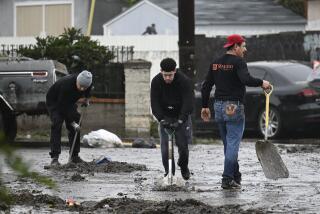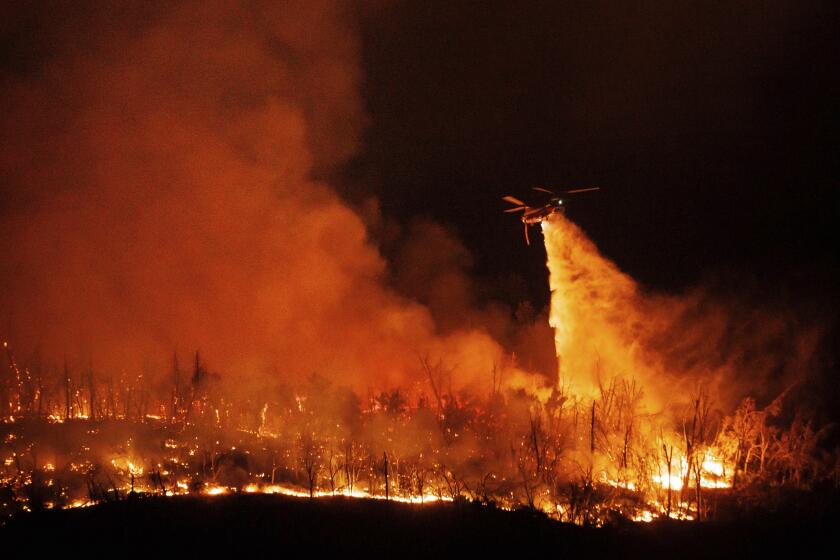
As climate change unleashes ever-more powerful storms, worsening floods and rising sea levels, San Francisco remains woefully unprepared for inundation, a civil grand jury determined in a report this week.
The critical assessment — written by 19 San Franciscans selected by the Superior Court — found that the city and county lacked a comprehensive funding plan for climate adaptation and that existing sewer systems cannot handle worsening floods. Among other concerns, the report also concluded that efforts toward making improvements have been hampered by agency silos and a lack of transparency.
Members of the volunteer jury serve yearlong terms and are tasked with investigating city and county government by reviewing documents and interviewing public officials, experts and private individuals. Jury foreperson Michael Carboy said it made sense to look into the issue of climate-related flooding because San Francisco is a “peninsula surrounded by water on three sides — and some would argue four sides, because the water is coming up from underneath.”
“There’s a couple hundred thousand people here, and at least 24,000 people, that are very much in harm’s way that will arise from both sea level rise as well as the consequences of extreme precipitation meeting the reality of a combined sewer system that was designed 40 or 50 years ago,” Carboy said. “We’re all going to be getting our feet wet.”
Aggressive and impactful reporting on climate change, the environment, health and science.
The report, titled “Come Hell or High Water: Flood Management in a Changing Climate,” focused on several city and county agencies, including ClimateSF, which was created by the mayor’s office in 2021 to bring together the San Francisco Public Utilities Commission, the planning and environmental departments, and the office of resilience and capital planning in an effort to coordinate and oversee climate resilience projects.
But the jury found that ClimateSF was better designed for planning, not implementation — and that it was struggling to bring projects to fruition. The report outlined a lack of coordination among departments, absenteeism at high-level meetings and a failure to publish annual reviews among its issues.
“Now that we are actively thinking about spending money on projects, the existing information-sharing platform is no longer the right platform,” said Carboy, a 29-year resident of San Francisco. “It doesn’t have the right governance model in place. It doesn’t have the right senior people working together as peers.... There is no coordination at the most senior levels with regard to planning, definitions of desired outcomes, and what victory looks like in this case.”

In a statement, officials with the city and county of San Francisco said they appreciated the civil grand jury’s work and will closely review its recommendations before responding formally to the report within 60 days.
“To meet our climate goals, climate resilience must be embedded into every department’s work,” the statement said. “ClimateSF brings together city departments to coordinate climate initiatives that reduce San Francisco’s climate risks and prepare the city to survive, adapt, and recover from climate hazards. Interagency coordination, planning, and strategic investments that ClimateSF facilitates are critical to meeting our climate goals.”
Researchers found evidence of two epic Southern California floods that occurred in the last 600 years and were much larger than the Great Flood of 1862.
The 71-page report outlines additional items of concern, including that San Francisco lacks a plan to aggregate the costs of climate adaptation, and that it pays for avoidable costs, such as compensating claims for flood damage that might be obtained by insurance underwriting.
While the jury is precluded from commenting on items beyond the confines of the report, the findings should speak for themselves, said Jonathan Cowperthwait, a Bay Area native and another member of the jury.
“This is not just a problem of governance and information sharing,” he said. “I would encourage every citizen who reads the report to remember the storms within recent memory that have led to water up to people’s knees.”
It was less than two years ago that California was hammered by a relentless series of atmospheric rivers. The storms caused extensive flood damage, landslides, downed trees and power outages in Monterey County, Santa Cruz and the San Francisco Bay Area, as well as at least 22 deaths across the state. More rain and snow pounded this region this winter.

San Francisco’s Hazards and Climate Resilience Plan, released in 2020, identified 23,700 residents at a risk of inland water flooding, or 2.7% of the city’s population. But increased warming driven by climate change will bring more extreme precipitation and put even more people in harm’s way, the jury’s report said.
It also noted that the sea level along the West Coast of the United States is projected to rise 4 to 8 inches by 2050, and possibly more than 3.5 feet by 2100. The increase will cause tide and storm surge heights to increase and reac farther inland, with “moderate” (typically damaging) flooding expected to occur 10 times more often on average than it does today, it said.
Carboy said the projections underscore the need for San Francisco’s politicians and leaders “to be honest with the city on what’s it going to cost to defend and protect the city with climate resilience and climate mitigation investments.”
“We have to do that, otherwise we are going to be ruining business areas. We’re going to be ruining neighborhoods from all areas of the economic stack — from the very well-heeled to the economically disadvantaged neighborhoods,” he said. “So it’s in our collective interest to understand just how big the problem is, to not pretend it’s not a problem, and to start taking planning action to do that.”
Human-caused climate is projected to bring wetter, more intense storms. Scientists explain what these shifts mean for California and the West.
Finances were a key part of the report. Climate resilience projects are not easily identifiable in the city’s accounting, which is hindering both management and audits, according to the report.
What’s more, the grand jury found that self-imposed limits on debt financing were keeping San Francisco from funding essential adaptation projects.
For example, policy dictates that some annual budgets approved by the Board of Supervisors limit the use of general obligation debt so as not to increase property owners’ tax rates above fiscal 2006 levels. Projections show that the city’s ability to issue additional general obligation debt will become hamstrung by this constraint as soon as 2028 — even without factoring in the billions that will need to be spent on seawall projects and improvements to the sewer system.
“As you can clearly see, we are at maximum debt capacity in 2028, and that’s before we’re even spending on some of these projects,” Carboy said.
But city officials said San Francisco has been, and continues to be, a nationwide leader on climate resilience — making strides on flood management, sea level rise and extreme heat and precipitation.
Since ClimateSF launched, the city has moved forward with Federal Emergency Management Flood Map Insurance Program implementation, and has launched a heat and air quality resilience plan, sea level rise guidance, a climate action plan and studies on extreme precipitation and groundwater, the city said in its response.
Officials also pointed to specific projects underway, such as the Ocean Beach Climate Adaptation Project. Ocean Beach, adjacent to Golden Gate Park, has experienced significant erosion in recent years, and the project outlines a managed retreat strategy that includes constructing a buried seawall to protect key infrastructure and enhancing coastal access and recreation. The project is slated for completion in late 2025.
Other projects include the Islais Creek Mobility and Adaptation Strategy, which will help protect the low-lying district against worsening flood hazards, and the Yosemite Slough Neighborhood Adaptation Plan, which aims to address disparities in climate adaptation planning in the coastal area.
“It’s clear that city departments share the goal of making San Francisco safer and more resilient to the impacts of climate change,” city officials said. “We recently hired a new program manager for ClimateSF, and we will continue to work on breaking down department silos and facilitating interagency collaboration on climate initiatives.”
Despite considerably back-to-back rainy winters in California, new research finds the region has seen much wetter years in the last 3,000 years. Experts worry that variability, coupled with climate change, could leave the state unprepared.
The San Francisco Public Utilities Commission similarly pointed to a variety of investments in capital projects that will help reduce the risk of flooding in low-lying neighborhoods, improve wastewater infrastructure and enhance stormwater capture capabilities. Since 2019, its Green Infrastructure Grant Program has awarded 20 properties with a total of $20 million for projects that will divert nearly 13 million gallons of stormwater from the collection system each year — or enough to fill more than 19 Olympic-size swimming pools, agency officials said.
“When it comes to infrastructure, we took a fresh look at our entire capital plan through a climate lens,” said John Coté, communications director. “Nearly every capital project in the latest iteration of the SFPUC’s 10-year plan is either as a result of climate change or seeks to ready our systems for the worsening impacts of climate change.”
The commission’s plan includes $11.8 billion in infrastructure investments over the next decade, he said.
Cowperthwait said the civil grand jury cannot make policy, only recommendations.
Among the recommendations outlined in the report are greater transparency around resilience projects; a rethinking of debt cap restraints; the creation of annual public reports summarizing the status of projects; and the development of a cross-departmental financial plan to relay the anticipated costs and potential funding sources for climate change resilience.
However, Cowperthwait said the city was cooperative and helpful throughout the process of creating the report.
“Everybody with whom we spoke was interested in helping explain and ultimately helping improve,” he said.
Carboy concurred.
“The goal of the city is to improve,” he said. “It’s just sort of how to get them to move toward improving.”
Toward a more sustainable California
Get Boiling Point, our newsletter exploring climate change, energy and the environment, and become part of the conversation — and the solution.
You may occasionally receive promotional content from the Los Angeles Times.











